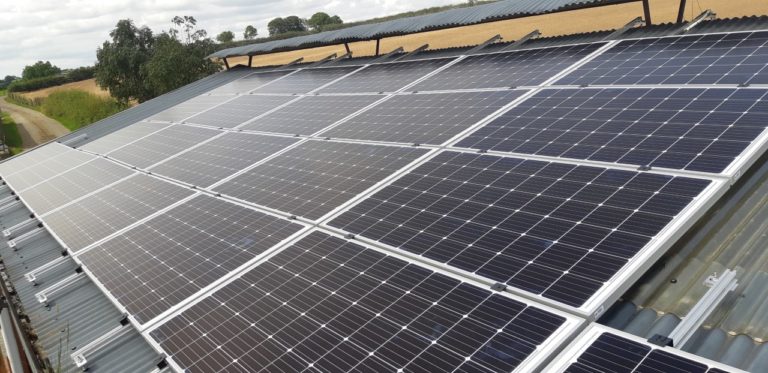The installation of solar panels on farms, across the country, is becoming a more frequent sight – especially on pig, poultry and dairy farms.
All three enterprises run up high electrical bills throughout the year. On pig and poultry farms this is the case for almost the entire year; while on dairy farms, when the milking parlour is in use, high electrical bills can be run up between February and November – for a spring-calving herd, for example.
To reduce these bills, some farms have gone down the route of installing solar PV systems. The decision to install solar panels on farms has become more popular due to the fact that there are grants available to install them.
It is also an attractive option for farmers who are looking to reduce their carbon footprint.
Solar panels have the ability to convert energy from daylight into electricity; the brighter the day the more generation takes place.
Benefits of solar PV
According to Local Power, who is a manufacturer and supplier of solar panels across Ireland, solar PV generates electricity from daylight with peak generation during February to October.
Pat Smith of Local Power explained: “Farmers investing in solar PV will reduce their bought-in electricity for decades to come.
“We design the system for farms to ensure all of the energy is used in the business for quickest payback. There is also a fantastic warranty on these systems, which is also an added bonus.
“For example, Local Power offers a German-manufactured panel, Solarwatt, which guarantees over 87% of its initial performance after 30 years.
“The amount of electricity generated from solar PV is very predictable and guaranteed with premium technology installs.
“With no moving parts, maintenance is low and monitoring of electricity usage can be provided to your smart device ensuring you know that your investment is delivering every day.
Contrary to a mistaken belief, solar PV electricity generation works very well under Irish conditions. The output from solar PV is very predictable.
“It varies from 800kwh to 1,100kwh per year per kilowatt peak (kWp) installed. This depends on the part of Ireland and on whether the panels are facing south or east/west.
“It is not recommended to face panels north unless the roof space is almost flat. Solar panels also work well on flat roof spaces tilted south or east/west. The PV panels have self-clean glass and the Irish rainfall does the cleaning job automatically.
“Solar PV generation systems are remotely monitored and farmers will be able to see the energy generated hourly, daily, yearly etc.”
Reducing Carbon Emissions
On the topic of reducing carbon emissions, Pat said: “For every 10kwp of solar PV that is installed on a farm, approximately 5t of carbon will be displaced per year. Solar PV will be a very visual sustainability initiative on farms.
“From our work to date with farmers they are very interested and keen to invest in this technology.
The low maintenance and predicable output are key advantages of solar PV over and above micro wind which from experience on farms has high maintenance and very unpredictable generation patterns.
“Also, with attractive install grants, farmers are becoming more interested in what solar PV systems have to offer.
“For example, a farmer in Co. Cavan – who installed installed a 6.5kWp solarwatt glass solar PV panel system with 4.8kWp of battery storage to act as a buffer between generation and usage and an EDDI device – was able to reclaim the VAT and write off 100% of the net investment cost in tax in one year.”



